#1980s Project Roundup
Explore tagged Tumblr posts
Text
The Ancient Key to The Tarot - 21 Books
The Lost Book Project is charging $13 for this collection. If you found this roundup useful, consider donating to the Internet Archive instead.
Other roundups here
Learning the Tarot by Joan Bunning (1998)
The Way Of Tarot by Alejandro Jodorowsky (2004)
Illustrated Key to the Tarot - Veil of Divination by L. W. de Laurence (1916)
The Ultimate Guide To Tarot by Liz Dean (2015) Ed note: This book is still very much in print; link is a rental
The Voynich Manuscript (Unknown)
Absolute Key to Occult Science. The Tarot of the Bohemians (1819)
The Pictorial Key To The Tarot - A. E. Waite (1910)
The Symbolism of the Tarot by P.D. Ouspensky (1913)
General Book of the Tarot by A.E. Thierens (1930)
The New Golden Dawn Ritual Tarot by Chic Ciero (1996)
Tarot Spells by Renee Jenina (2000) Ed note: This book is still very much in print; link is a rental
Tarot Spreads - Get The Whole Story by James Ricklef (2004) Ed note: This book is still very much in print; not linked.
The Magical Ritual of the Sanctum Regnum (Unknown)
The Game of Life by Timothy Leary (1978)
The First Book of Luciferian Tarot by Michael Ford (2007) Ed note: This book is still very much in print; not linked.
Understanding Aleister Crowleys Thoth Tarot by Lon Milo Duquette (2002)
The Tarot by S. L. MacGregor Mathers (1888)
Fortune-Telling by Cards by P.R.S. Foli (1900)
The Book of Thoth Book by Aleister Crowley (1944)
Introduction To The Study Of The Tarot by Paul Foster Case (1920)
Meditations On The Tarot by Valentin Tomberg (1980)
24 notes
·
View notes
Text
Time for a New Pinned Post
Hi, I'm Drew Cook. I'm probably best known for my long-form criticism of 1980s text adventure games by a company called Infocom. They made thirty-five games in total, and are probably best-known for the Zork trilogy of games. My interests as a critic are mostly cultural and historical. For instance, I choose to look at Zork through a post-colonial lens.
My work has been featured at Critical Distance many times, including their "2022 Year in Videogame Blogging" roundup.
When I stick to my posting schedule (every two weeks), I get around five hundred unique visitors a month. That's pretty large for such a niche topic. Reactions to the site have made me very happy. It's called Gold Machine. Come pay me a visit!
I have also collaborated with Callie Smith on a few podcast episodes about Infocom games. It's called Gold Microphone. Unfortunately, we haven't had time to update it in a long, long while. We still want to get back to it. Last time I checked, it was on all major podcasting platforms.
I also write parser interactive fiction. My first game, Repeat the Ending, is a work of speculative metafiction about grief, mental illness, and the second law of thermodynamics. I tried to resist the tendency of parser games to be about things, focusing instead on narrative, psychological portraiture, and lots and lots of paratext. In fact, one of its themes is concerned with the limitations of parser-based narratives. It's been well-received so far, and earned ribbons for Best in Show, Best Art, and Best Writing in Spring Thing 2023. You can check it out here (linked below) and read some nifty extras, including the source code. Note the "play online" button at top right, and don't forget to save your game!
Feel free to ask me anything about game criticism, RTE, or even my work in progress. Or something else, it's cool.
I'm considered disabled due to the severity and prognosis of my mental illness. I'm not going anywhere with that; I'm just saying.
If you enjoy any of my projects, including my recently started posts about Inform 7 for beginners, consider telling your friends about it/them, or even rating Repeat the Ending at IFDB if you felt it was worthwhile. I do all of this for free, and always will, so knowing people find value in my work is what motivates me.
#interactive fiction#inform 7#parser#gold machine#infocom#zork#bipolar I#repeat the ending#pinned post#game criticism#cultural analysis#media studies
11 notes
·
View notes
Photo










1980s Project: 1983
Deathstalker
2019: After the Fall of New York
Born in Flames
Christine
Deal of the Century
Escape from the Bronx
High Road to China
Blue Thunder
Exterminators of the Year 3000
Brainstorm
17 notes
·
View notes
Link
LETTERS FROM AN AMERICAN
August 1, 2021
Heather Cox Richardson
August 1, 2021 (Sunday)
Last Sunday, educator and civil rights leader Dr. Robert Parris Moses died at 86.
Born in New York City in 1935, the son of a homemaker and a janitor, Moses was working on a PhD at Harvard when his parents’ health brought him back to New York City. There, he began to teach math in 1958.
In 1960, images of Black Americans in the South picketing for their rights “hit me powerfully, in the soul as well as the brain,” he later said. He moved to Mississippi and began to work with the Student Nonviolent Coordinating Committee (SNCC, pronounced “snick”). In 1961, he began to direct SNCC’s Mississippi Project to promote voter registration in Mississippi, where, although about 40% of the state’s population was Black, most Black Americans had been frozen out of the polls through poll taxes, subjective literacy tests, and violence. In his quest to get people registered to vote, Moses endured attacks from thugs wielding knives, white supremacists wielding guns, and law enforcement officers wielding power. He earned a reputation for being quiet and calm in times that were anything but.
By 1964, Moses was one of the key leaders in the effort to register Black voters in Mississippi. In April, working with Fannie Lou Hamer and Ella Baker, he helped to found the integrated Mississippi Freedom Democratic Party to challenge Mississippi’s all-white Democratic Party.
That summer, Moses led the Freedom Summer Project to bring together college students from northern schools to work together with Black people from Mississippi to educate and register Black voters. On June 21, just as the project was getting underway, Ku Klux Klan members working with local law enforcement officers murdered three organizers outside Philadelphia, Mississippi: James Chaney, from Mississippi, and Andrew Goodman and Michael Schwerner from New York. The white supremacists buried the bodies in an earthen dam that was under construction. When the men disappeared, Moses told the other organizers that no one would blame them for going home. His quiet leadership inspired most of them to stay.
On August 4, investigators found the bodies of the three missing men. The Mississippi Freedom Democratic Party met on August 6 and decided to challenge the Mississippi Democratic Party to represent the state at the Democratic National Convention. And yet, when the Democratic National Convention met, the Democratic National Committee leaders and President Lyndon B. Johnson chose to recognize the all-white Democratic Party rather than the integrated ticket of the Mississippi Freedom Democratic Party.
At the end of 1964, Moses resigned from his leadership position in Mississippi, worried that his role had become "too strong, too central, so that people who did not need to, began to lean on me, to use me as a crutch." Key to Moses’s leadership was that he did not want to be out front; he wanted to empower others to take control of their own lives.
Civil rights historian Taylor Branch told reporter Julia Cass in a story Mother Jones published in 2002: “Moses pioneered an alternative style of leadership from the princely church leader that [the Reverend Martin Luther] King [Jr.] epitomized…. He was the thoughtful, self-effacing loner. He is really the father of grassroots organizing—not the Moses summoning his people on the mountaintop as King did, but, ironically, the anti-Moses, going door-to-door, listening to people, letting them lead.”
Moses was disillusioned when the Mississippi Democratic Freedom Party did not win the right to represent the state in the Democratic National Convention. For all the work that individual sharecroppers and hairdressers and housewives had done in Mississippi, national leaders had let them down. “You cannot trust the system,” he said in 1965. “I will have nothing to do with the political system any longer.”
Moses turned to protesting the Vietnam War. He and his wife, Janet, moved to Tanzania when he was drafted despite being five years over the cutoff age. After 8 years in Africa, the Moses family moved back to Cambridge, Massachusetts, where Moses resumed his doctoral work in the philosophy of mathematics.
Back in America, Moses turned his philosophy of empowerment to the schools, advancing the idea that mathematical literacy is central to the ability of young people to participate in the twenty-first-century economy. In the 1980s, he launched The Algebra Project to give young Americans access to higher mathematics. “I believe that the absence of math literacy in urban and rural communities throughout this country is an issue as urgent as the lack of registered Black voters in Mississippi was in 1961,” he wrote. “In the 1960s, we opened up political access…. The most important social problem affecting people of color today is economic access, and this depends crucially on math and science literacy, because the American economy is now based on knowledge and technology, not labor.”
Moses’s focus on empowerment and self-determination was very much in keeping with the original concept of American democracy.
And yet, his efforts, along with those of the Mississippi Freedom Democratic Party, to turn to national politicians to cement gains at the grass roots were not in vain. In 1965, Congress passed and Johnson signed the Voting Rights Act, protecting the rights of Black Americans to vote, focusing on states with historical voter suppression.
Just fifteen years later, in 1980, Republican presidential candidate Ronald Reagan spoke at Philadelphia, Mississippi, where he defended state’s rights, and the unwinding of the civil rights advances of the post–World War II years began.
Now, in 2021, we seem to be headed back to the one-party society Moses fought. In response to record voter turnout in the 2020 election, 18 states have passed 30 new laws that make it harder to vote. At the same time, Republican-dominated legislatures are gathering into their own hands the power to override the voters.
In Louisiana on Friday, Republican House Speaker Clay Schexnayder removed three Democrats and one unaffiliated member from committee leadership positions in retaliation for their unwillingness to override the Democratic governor’s veto of a bill banning transgender girls from participating in school sports. They will be replaced by Republicans.
In Georgia, legislators have begun the process of transferring control of the elections in Fulton County, one of the most reliably Democratic counties in the nation, from county officials to Republican state officials.
Public schools are also under attack, with Republicans threatening to cut funding to schools that require masks to stop the spread of coronavirus or that teach “divisive concepts” that make students uncomfortable, usually topics that involve race.
Republican lawmakers have proposed attaching funding to students rather than to schools, enabling parents to use tax dollars to enroll their children in private schools. This sounds like a revival of the all-white “segregation academies” that sprang up in the South after the Supreme Court required desegregation of public schools. Those academies, funded with public money, were so successful that, according to Professor Noliwe Rooks, an Americanist who specializes in issues of race and education and who chairs the Africana Studies department at Brown University, in 1974, 3,500 academies in the South enrolled 750,000 white children. As white students left the public schools, funds available to educate the many Black and few white children left behind fell drastically.
Unequal educational options were hallmarks of the one-party state systems Moses worked to undermine. When he explained The Algebra Project, Moses called the historically limited educational opportunities for Black children in America “sharecropper schooling.” “[Y]ou went through it, but your options were you were going to chop and pick cotton or do domestic work….”
In 1965, Congress and the president finally recognized that all the organizing in the world couldn’t overcome the apparatus of a rigged system. They used the power of the federal government to turn the work of individuals like Bob Moses, scholar and visionary, organizer and teacher, into the law of the land.
But watching the turbulence in American life last year, Moses warned that the nation “can lurch backward as quickly as it can lurch forward.”
—-
Notes:
https://www.motherjones.com/politics/2002/05/moses-factor/
https://www.nytimes.com/2021/07/25/us/bob-moses-dead.html
https://www.nytimes.com/2020/06/17/us/george-floyd-protests.html
https://www.brennancenter.org/our-work/research-reports/voting-laws-roundup-july-2021
https://www.politico.com/news/2020/07/08/trump-schools-reopening-federal-funding-352311
https://www.nytimes.com/2018/11/28/opinion/cindy-hyde-smith-mike-espy-senate-mississippi.html
https://apnews.com/article/louisiana-8eaa96bcc646a118a70b95a06994c2d3
https://www.ajc.com/politics/capitol-recap-georgia-moves-closer-to-takeover-of-fulton-elections/O2ZVJZ3NKRD7HP5QHTSBIXUQ34/
LETTERS FROM AN AMERICAN
HEATHER COX RICHARDSON
#political#biography#Civil Rights#history#Heather Cox Richardson#Letters From An American#corrupt GOP#criminal GOP
5 notes
·
View notes
Photo

Jacques Chirac, former French president, dies aged 86
The former French president Jacques Chirac, a self-styled affable rogue who had one of the longest political careers in Europe, has died aged 86.
For several years he had suffered from memory loss said to be linked to a form of Alzheimer’s disease or to the minor stroke that he had while in office.
Chirac, who was head of state from 1995 to 2007, boasted one of the longest continuous political careers in Europe – twice president, twice prime minister and 18 years as mayor of Paris.
Although his time as president was marked by inaction and political stagnation, and despite having left France just as divided and struggling with mounting debt, inequalities and unemployment as he had found it, his debonair persona meant that in retirement he was embraced as one of France’s favourite politicians.
Chirac will be remembered internationally for leading France’s strong opposition to the US-led invasion of Iraq in 2003, when approval ratings for his anti-war stance in France soared to 90%. “War is always a last resort. It is always proof of failure. It is always the worst of solutions, because it brings death and misery,” he said a week before the US-led coalition forces invaded Iraq. He warned that any occupation of Iraq would prove a “nightmare”.
One of Chirac’s greatest gestures at home was to reconcile the nation with its history by acknowledging that France as a whole was responsible for the roundup of some 76,000 Jews sent to Nazi death camps during the second world war. His vow that the “criminal folly” of the German occupation was “assisted by the French people, by the French state” lifted the last taboo of the occupation and the collaborationist Vichy regime. His apology was the first time a postwar French head of state had fully acknowledged France’s role.
Chirac will be remembered above all as a master in the art of political seduction. For decades he charmed the public with his endless handshaking, patting of cows’ backsides and shaking of dogs’ paws on his tours around France – a beer-drinking, Gitanes-smoking man of the people who was able to eat five lunches in one afternoon on the election trail.
He shook so many hands while criss-crossing France that he used to plunge his fingers into a bucket of ice at the end of the day or wear plasters to protect from the blisters he got from his powerful grip on pensioners and farmers. He had a visceral need to reach out and touch people – whether it was hugging an elderly voter or flamboyantly kissing the hand of the German chancellor, Angela Merkel.
Chirac was much mocked, often satirised and once nicknamed “Superliar”. After a historic trial in 2011, he became the first former president to be convicted of corruption following embezzlement charges in a party funding scandal when he was mayor of Paris. Yet he was seen to embody the French president’s role as republican monarch with a kind of panache that Nicolas Sarkozy and François Hollande would later be found by the public to be lacking.
Politically he was known as the “weathervane”, for his ability to shift as it suited him. He went from championing state control in the 1970s to Ronald Reagan’s free-market liberalism in the 1980s. When he was elected president in 1995, he shocked the world by resuming nuclear testing in atoll explosions in the South Pacific, then took to the stage as an eco-champion at the 2002 Earth summit, warning: “Our house is burning while we look elsewhere.” He went from virulent eurosceptic in the late 1970s to staunch euro-defender 10 years later.
During more than 43 years in politics, Chirac was described as a “bulldozer” and “killer” of rivals. Born to well-off but progressive parents in Paris, what really marked him was his military service on the frontline during the Algerian war – he was the last French president to have direct experience of combat and it left him both a fan of military strategy and cautious about war.
He was a figure in French political life from the early 1960s, starting as an adviser to the prime minister George Pompidou, becoming an MP in rural Corrèze and then a minister. Before he finally became president in 1995, he founded a political party, the Gaullist Rally for the Republic, served twice as prime minister and failed twice at a presidential election. It was his ability to take knocks and get up again that proved part of his charm.
When Chirac became president in 1995, he promised to heal the “social fracture”, the crippling unemployment, division and inequalities that plagued France. But instead, his government’s contested pension reform and planned austerity package of social security cuts prompted up to 2 million people to take to the streets, paralysing France in the worst strikes since May 1968. His term was then hamstrung by his disastrous decision to call parliamentary elections in 1997 in a bid to boost his support. The Socialists won, forcing Chirac into uncomfortable power-sharing.
In 2002, he was re-elected president with 82% of the vote after the Front National’s Jean-Marie Le Pen shocked the nation by getting into the final round run-off. Chirac won because much of the leftwing electorate voting for him in order to stop the far-right leader. He later said one of his biggest regrets was not having formed a mixed national-unity government with ministers from all political sides. Instead, he stuck to his own brand of centre-right politics. In 2002 he agreed common agricultural policy payments with Germany, securing his popularity.
At home, he was most criticised for failing to steward change in France, avoiding reforms, and allowing inequalities to fester, symbolised by the 2005 urban riots on housing estates across France. The same year he called a referendum on approving the proposed EU constitution but then failed to sell the idea to the electorate, who voted no. It was a devastating blow. His popularity ratings near the end of his term were the lowest of any president since the war.
Among his success stories in office was his fight to improve road safety which was calculated to have saved 8,500 lives in four years. He ended compulsory military service and reduced the presidential term from seven years to five.
He was a lifelong source of barbed quotes and digs, famously asking in reference to Margaret Thatcher: “What more does the bag want, my balls on a platter?” He once said of Britain: “You can’t trust people who cook as badly as that.” But he also made comments he would regret. “Africa is not ready for democracy,” he told a group of African leaders in the early 1990s. When mayor of Paris in 1991, he made a controversial speech about immigration and talked of French people being disturbed by “the noise and the smell”, sparking outrage.
Like François Mitterrand before him, Chirac wanted to leave behind a great cultural project and created Paris’s Quai Branly museum, a riverside monument to himself as the “great defender” of African, Asian, American and other indigenous cultures.
Throughout his presidency, he was dogged by the sleaze scandals from his days as mayor at Paris city hall. He claimed immunity as president, but when he left office he swiftly became the first former president convicted of a crime. Aged 79, he was handed a two-year suspended prison sentence after being found guilty of embezzling public funds as Paris mayor in order to illegally finance the right wing party he led.
His lawyer, Georges Kiejman, said at the time: “What I hope is that this ruling doesn’t change in any way the deep affection the French feel legitimately for Jacques Chirac.”
It was a mark of Chirac’s extraordinary life and luck that it didn’t.
Daily inspiration. Discover more photos at http://justforbooks.tumblr.com
32 notes
·
View notes
Text

Beautiful Tokitae.
Today marks 49 years since she was captured in the infamous Penn Cove roundup; the capture that prompted public outrage and led to orca captures being outlawed in American waters. 5 whales died during the capture process, 7 were sold to marine parks. These captures are one of the factors that heavily contributed to the initial decline of the Southern Resident population in the 60s and 70s. Tokitae is the only survivor of those captures, captured at age 6 and now age 55. This makes Tokitae the last living captive orca captured in the states, the last Southern Resident in captivity, and the oldest orca in captivity. She now resides and performs at the Miami Sequarium under the name “Lolita” in a tank whose dimensions violate the marine mammal protection act, at only 35 feet long at its widest point, and 20 feet deep at the deepest point (for reference, Tokitae is 22 feet long!). While she has dolphin companions in her tank, she hasn’t had the company of another orca since 1980. While Tokitae’s story is heartbreaking on many accounts, there isn’t an easy solution or fix to the wrongs that have led to her circumstances. She’s an old animal, adverse to environmental changes, but in good physical health. While her living situation is far from ideal, the fact she appears to make the best of it is a testament to her spirit as an individual. There isn’t an easy solution to help Tokitae that would please everyone and be in her best interest, so this piece isn’t meant to be a statement, I was just thinking about her today. Her situation is messy and complicated; unlike her, her situation and it’s moral standing are just not black and white. Freeing Tokitae or retiring her to a sea pen like many advocates want, isn’t cut and dry, and fails to acknowledge her history of not handling major environmental change well (stadium renovations in the past and even show changes are things she has responded to poorly), or potential pathogen exchanges that could put her or their animals at risk. A whale her age has also never been transported, and that is a risky endeavour in itself. Upgrades to her tank to bring it up to code would also require a lot of change, and noise which dolphins and whales are very sensitive to. However, it is hard to ignore the fact she is housed without orca companionship, and in an illegally small tank. Most people can agree that that is not an appropriate environment for an animal like her, however the best course of action might be to learn from her and ensure this doesn’t happen to more animals in the future.
While Tokitae’s situation is messy and hard to navigate, we can help her family. Toki’s wild family who live off the coast of British Columbia and Washington have been struggling and declining rapidly in recent years. If you want to help ensure her family can grow and thrive, support the whale museum and Center for whale research, oppose pipeline projects that lead to the Pacific Northwest, and put pressure on the Washington state government to breach the snake river dams and restore salmon runs. While orca captures were the cause of their initial decline, that issue has long since been addressed. Their current threats are boat traffic, pollution, and their most major threat is decline in food, with salmon populations struggling in their home waters.
Photo reference by EarthEmerald & RaptorFire Photography
#aleksi draws#aleksi ann#aleksiann#painting#orca#killer whale#watercolor#cetacean#sea life#gouache#art#artists on tumblr#miami seaquarium#free lolita#lolita#tokitae#yxe#yxeart
31 notes
·
View notes
Text
Recommended Reading

Providing A Freshly Curated, Weekly Link List on Christianity & Culture.
Find my weekly recommended reading with the RR tag. Dedicated link posts with personal commentary can be found through the link tag. Real-time news and article sharing happens on Twitter and my Facebook page.
I love seeing new things on the Internet and reading and your comments, so please keep in touch. And to get all of my articles, exclusive insight, and more from my many projects, subscribe to my newsletter.
On Fridays, I contribute a curated link column specifically for SOLA Network readers. I hope to highlight articles related to Asian American issues and blog posts written by Asian American authors. You can read my 16th roundup from last Friday.
Christianity
When Grandma and Grandpa Don’t Love Jesus
When You Don’t Have a Good Dad on Father’s Day
Building a spiritual legacy
What Is the Essence of Manhood?
Why God Made Your Mouth
4 Things Teens Need from Your Church
Matrimony and the Mind: The Need for Husband-Theologians
Selfie-Syndrom: Overcoming Narcissism
Podcast: Verses That Changed My Life (John Piper)
Stop Loving Your Spouse Too Much
The Way Out of Doubt
Help! My Teen Doesn’t Want to Attend Church
Five Ways Congregational Worship Shapes Us
Envy and the Seminarian
Let’s Anticipate the Incredible Experience of Worshipping in Heaven with All God’s People
Human Rights Under Fire in Hong Kong: What’s Really Behind the Massive Protests
Episode 3: Writing, Teaching, and Women in Ministry with Jen Wilkin
Whether I Sink Too Low or Soar Too High
You Were Designed for Spirituality
5 Questions to Ask When You Are Suffering
Stop Praying “Be With” Prayers
Technology and Our Anxious Hearts
Distinguishing Marks of a Quarrelsome Person
Is Our Visual Age Making You Blind?
Why the Third Day? The Promise of Resurrection in All of Scripture
7 Ways to Shepherd the Terminally Ill
Meditation Apps and the Gospel of Self-Optimization
An Unexpected Strategy for Reaching the Muslim World
I Never Understood Burnout or Depression—Until It Happened to Me
Five Intriguing Updates on Gen Z and Churches
Help! My Teenager Won’t Open Up to Me
The Rightful Risks of Motherhood
How to Avoid a Preaching Rut
The New Issue of Credo Magazine Is Here: The Aseity of God
Bad Bible Interpretation Really Can Hurt People
You're Not Entitled to Ministry
Breaking the Power of Shame
BJ Thompson on Communicating Mercy Within Marriage
Paul Tripp on How Parents Can Model Mercy
Reading the Bible Upside Down: Why the Pope Changed the Lord’s Prayer
Should My Boyfriend and I Travel Alone?
The Priority of Preaching
The FAQs: Southern Baptists Release Urgent Report on Sexual Abuse
The Greatest Gift to Your Pastor
Remembering David Powlison, a Faithful, Jesus-Loving, and Gospel-Centered Brother
3 Barriers to Spiritual Growth Faced by Teens Today
Powlison: 5 Questions to Ask When You Are Suffering
The Reformed View of Predestination
Culture
Q&A: 'Always Be My Maybe' Stars Ali Wong and Randall Park on the Netflix Rom-Com
Anberlin Talk Reconciliation
Classic Songs From 1970s and 1980s Recreated With Era Appropriate Synthesizers, Instruments and Effects
Tour of a Magnificent Five Story Church Organ With 8,000 Pipes of Vastly Different Sizes and Weights
26 Things We Learned from the ‘Captain Marvel’ Commentary
Welcome to the wonderful world of bizarre literary Instagram accounts
Matt Braly launches Disney Channel’s ‘Amphibia’
The cast of Sesame Street offers the most heartwarming Tiny Desk concert ever
‘X-Men: Days of Future Past’ Could Have Been the Perfect Franchise Ending
Superhero Bits: Quentin Tarantino’s Favorite MCU Movie, ‘Guardians of the Galaxy’ Goes 8-Bit & More
1 note
·
View note
Text
8 Things to Know About the Meat And Cancer Debate
Have you heard about the meat and cancer debate? Does eating meat increase your risk of cancer? Read this article to get the best answers.
Pop question: Does Meat Cause Cancer?
The jury is out: Meat—good or bad? The vegan and vegetarian camps say “Nay!,” the meat lovers say, “Yay!” Who is right? Moreover…does meat really cause cancer? Read on to find out what the research says.
The Great Meat And Cancer Debate
The great meat debate has been an ongoing source of conflict between varying groups for the past 20 years—particularly since the release of the famous “China Study” book, published in 2005, often cited as the leading authority on the reasons to NOT eat meat.
In it, the authors explain the 1980’s “China Project” research study in layman’s terms, concluding that that people should eat a predominantly plant-based diet—excluding animal products (including beef, pork, poultry, fish, eggs, cheese, and milk), processed foods and refined carbs—in order to avoid, reduce, and reverse the development of numerous diseases.
The truth? There really are lots of studies out there linking meat consumption (especially red meat) to cancer.
Regardless of the type of meat consumed (organic, grass-fed, etc.), researchers have uncovered several components linking cancer with meat that have nothing to do with what an animal eats, hormone or antibiotic exposure.
However, does this link actually mean that meat causes cancer, or is there something else that sets the stage for meat to cause cancer?
10 Things You Need to Know About the Meat & Cancer Debate
(These are the things that most news headlines won’t tell you).
1. Cancer is an Autoimmune Disease (Anti-Inflammatory Foods are Best)
Call it cancer, Lupus, Hashimoto’s, Celiac disease, or any one of the other 100+ autoimmune diseases now classified by the CDC, all autoimmune diseases share a common link—your body is attacking itself (autoimmune response).What causes this autoimmune response in the first place? Inflammation, or “stress.”
Inflammation and stress are interchangeable terms in the autoimmune disease presentation. Anything that causes inflammation is a “stress” to your body—setting you up for the perfect storm of autoimmune disease (i.e. body attacking itself). Stress goes far beyond mental stress. It includes things like:
Toxins in the cleaning & hygiene products
Tap water consumption
Lack of sleep
High screen & light exposure
Lack of exercise or too much exercise
Longterm medication use or antibiotic use
Pesticides on fruits & veggies
Gut irritating foods (high intake of grains, sugar, processed, hydrogenated oilsor refined foods)
Hormones & antibiotics in meats and dairy
Lack of balance in the diet
Gut dysfunction (low stomach acid, low digestive enzymes)
Given these facts, high meat consumption can certainly be a source of inflammation for some people—particularly depending on the type of meat consumed (organic vs. conventional); a lack of veggies in the diet; or low stomach acid (that helps digest the meat in the first place). However, as noted above, meat is NOT the only source of inflammation in the body connected to stress and disease.
Essentially, any time we lack balance (such as lacking nutrient-dense foods in our diet) stress and inflammation happens.Other examples of dietary stressors that trigger inflammation for some people may include:
High amounts of raw and cruciferous vegetables
FODMAPS are difficult for some people to digest and break down—especially those with SIBO, IBS or gut issues.
Whole Grains
Unfortunately, most of the grains sold in the U.S. today are highly processed, pseudo-versions of grains, filled with enriched flours, fillers, sugar and oils; or not properly soaked or sprouted, containing heavy amounts of phytates and lectins (1) that our digestive tract cannot break down.
Sugar & Artificial Sweeteners
Sugar feeds cancer cells (2). Artificial sugar is not much better, correlated with tumors and various forms of cancer in multiple studies cited by the National Cancer Institute (3).
High Fat without enough greens—
For those with a sluggish, under-functioning, liver-gallbladder, fatty foods can be more difficult to digest—particularly in the face of low green and veggie intake (4, 5). (No, fat is not bad for you, but if you, once again, lack balance then inflammation risk is higher)
In short: Cancer is an inflammatory autoimmune disease that is triggered when your body encounters various inflammation and stressors. Certain dietary triggers (like poor quality meat consumption, or lack of veggies with your proteins) may be more “inflammatory” to some people, whereas other stressors, (such as lack of sleep and smoking) are more present and inflammatory for others.
The Bottom Line:
Focus on an anti-inflammatory, nutrient-dense diet to fight off cancer. (And yes, protein can be included).
2. Leaky Gut is a Root of Cancer
Hippocrates said it best: “All disease begins in the gut.”“Leaky Gut” and an unhealthy gut microbiome is another common link that all autoimmune diseases—including cancer—share (6, 7, 8, 9).Unfortunately, for a long time, debates over “what causes cancer” have been heavily weighted at particular foods and lifestyle stressors, such as meat, smoking and lack of fruits and veggies (10). However, valid or not ,the root cause is often missed in all these studies, claims and debates—leaky gut. This cancer debate needs answer.
Your gut is the gateway to your health! If your digestive tract and gut microbiome are unhealthy, then you are LESS likely to digest and absorb your nutrients properly to feed the rest of your organs and cells.
Additionally, in the case of “leaky gut,” food particles and foreign proteins from the foods you eat seep into your bloodstream, undigested, where your body’s immune defense system then attacks itself to get those proteins out of there (i.e. “autoimmune response” or “autoimmune disease”). If this happens continually, over time, this autoimmune attack wreaks havoc on your health, resulting in various autoimmune disease presentations or symptoms. In functional medicine we say, “Genetics load the gun, BUT environmental factors (diet, gut health and lifestyle) pull the trigger.”
The Bottom Line:
You may have the genetics for cancer or other health conditions, but only when other environmental factors are “stressed” (like your gut health) is when that cancer presents itself. We still have a lot to learn about the influence of the microbiome on health and disease, but we know enough already to conclude that the gut-disease link is significant. Many people are talking about this during cancer debate.
Do you have a “leaky gut?” Find out here, plus insider tips on how to fix it here.
3. Stomach Acid is Crucial
Stomach acid is essential for the digestion of food—especially protein (10, 11). Your stomach acid has a pH of 1.5-3.5 on a total 14 point scale (translation: It’s HIGHLY acidic). Unfortunately, stomach acid deficiency is common in people due to high amounts of stress humans have adapted to today. Examples of stressors that wreak havoc on your stomach acid levels include:
Long term medication use
NSAID/steroid use
Antibiotic use
Lack of prebiotic fiber and probiotic rich foods
Not chewing your food well
Eating on the go or distracted
Overtraining
Lack of sleep
And, yes, even high amounts of mental stress
Stomach acid, also known as “hydrochloric acid,” is essential for the break down of all foods, but particularly proteins.
Without enough stomach acid, proteins in foods can pass into the rest of the GI tract only partially broken down and digested from the stomach—making effective digestion even more challenging throughout your small and large intestine.
The result? Increased likelihood of leaky gut, and other gut-related issues correlated with an unhealthy gut microbiome and disease (including cancer) (13). Interestingly, several studies show that people with long-term PPI medications use (drugs that “boost” stomach acid) experience up to a six-fold risk for getting cancer (14, 15). Why? These drugs essential decrease your natural stomach acid production.
The Bottom Line:
Meat itself may not be the culprit of cancer, but instead an unhealthy gut microbiome and low stomach acid that was unable to break down your meat in the first place.
4. Meat Studies Don’t Necessarily Use “Healthy” Controls
Given that 1 in 2 Americans already have a chronic disease in our country, are studies with “average” controls of the population really all that healthy?While syndromes and diseases like IBS, acne, allergies, anxiety, constipation, pre-diabetes and more may be considered “healthy,” “normal,” or “average” in our society, these issues typically signify something else (health related) is going on under the hood—especially gut health and hormone related.
The Bottom Line:
When interpreting a study that claims “meat causes cancer,” or “carbs cause weight gain,” or even “broccoli causes cancer,” ALWAYS question: Who were the test subjects? What was their current lifestyle, diet and gut health like? There’s often more to the story than meets the eye.
5. Meat Contains Carcinogens (& So Do Plants)
Compounds in meats (salts, nitrates, nitrites, heme iron, saturated fat with toxins in the fat cells, estradiol) have been theorized to increase DNA synthesis and cell proliferation, increase insulin-like growth factors, affect hormone metabolism, promote free radical damage, and produce carcinogenic heterocyclic amines—all of which may promote the development of cancer (16). However, these components, prevalent in many processed and conventional meats are not prevalent in sustainably-raised, grass-fed, pastured and local meats.
The Bottom Line:
Bad quality meat (17) is linked to cancer (think: processed and conventional)—and so are carcinogens in fruits and veggies (i.e. Roundup, pesticides, etc.) (18).
6. You Need Greens with Your Meat
The “problem” with high meat diets—or even cancer and meat studies—is that often times, these studies LEAVE OUT the OTHER important components to the human diet, digestion and absorption—particularly fiber!Fiber (19), found in veggies and fruits, is essential for “pushing food” through your digestive tract and also helping probiotics (good gut bacteria) stick in your gut (20, 21).
No wonder inflammation happens in meat studies! And many are taking about in in any cancer debate. The same thing goes for high-fat diet studies, where participants tend to leave out the whole-food carbs (i.e. greens), and opt for the standard American diet—full of hydrogenated oils, proteins, and refined processed foods and carbs. Duh, inflammation will happen.
The Bottom Line:
Get your veggies on! Bonus: Incorporate fermented foods into your diet daily.
7. Meat Variety is Essential (Just Like Fruit & Veggie Variety is Essential)
Red meat has long been touted as the “bad meat”—highest connected to cancer. However, in consideration of ALL the other facts we’ve addressed, red meat is simply the most often studied in meat studies (perhaps due to the bad rep it also has gotten over the years for “causing heart disease” and high cholesterol—however, these claims have also been debunked) (22).
The bigger “culprits” than red meat vs. chicken vs. fish? Ask yourself these questions: Question 1: How is my gut health and stomach acid for breaking my meat down in the first place?Question 2: How is my meat and food variety in general?Question 3: Where is my meat source from? (Grass-fed, organic and sustainable raised or full of hormones and antibiotics?). This are the common questions when it comes to meat and cancer debate.
Just like it would be “unhealthy” to eat grapes and iceberg lettuce for your only sources of fruits and veggies every day; and just like it would be “unhealthy” to fuel up on a heavy dose of Roundup (a pesticide) in your fruits and veggies, the same thing goes for red meat.
The Bottom Line:
Red meat itself is not “bad”—it’s all about the context. Boost stomach acid with apple cider vinegar or HCL tablets at meals; opt for a grass-fed cut of meat; and vary up your proteins often (beef, chicken, fish, turkey, etc.)
8. Whole Grains, Iceberg Lettuce & Vegan Ice Cream Can ALSO “Cause Cancer”
It’s no secret: Processed, man-made, refined foods are not real foods. And what do we know about real foods?…They cause inflammation in the body. True, high meat consumption without enough stomach acid, variety and/or poor quality meats is inflammatory; but so is a diet rich in gut-irritating whole grains (i.e. cereals, quinoa bowls, oats), nutrient-deficient iceberg lettuce, and vegan ice cream, laced with synthetic ingredients like: guar gum, erythritol, vegetable glycerin, pea protein and other inflammatory fillers.
The Bottom Line:
Eat real, nutrient-dense foods to fight cancer.
The BIG Bottom Line:
A colorful, plant-based, nutrient-dense diet IS the optimal human diet.
In addition, if we really want to “study” the facts on what the optimal human diet is for disease and cancer prevention, who better to look to than our ancestors who were practically free of all modern day diseases we experience today (autoimmune disease, high cholesterol, heart disease, and cancer)? This is a part of the cancer debate.
Also, studies of indigenous, hunter-gatherer populations who live lifestyles like those our own ancestors lived thousands of year ago, reveal similar findings: low disease rates and generally healthy people (23, 24, 25).
The optimal hunter-gatherer diet greatly depended on the terrain, season and geographic location in which one lived, however a few key universal themes true for most human are these:
High intake of colorful plants (vegetables, berries and plant “oils”—like olives, avocados and coconut)
Meat and fish, when hunted and available (i.e. not an 8 oz steak for every meal)
Minimal starches, beans and grains, if at all
Minimal raw dairy
Some nuts and seeds
In short:
If we model a similar diet to the optimal human diet that humans remained cancer-free on for thousands of years, support our gut health (25), and minimize stress in our own lifestyles, the whole “meat causes cancer debate” becomes a thing of the past.
Cancer-Fighting Diet
An anti-inflammatory does a body good—particularly in the face of cancer or other autoimmune diseases. Furthermore, here are some anti-inflammatory super foods to add to your grocery list and regular part of your diet. (Note: This is not an exhaustive list, but several of the top players in fighting inflammation).
Antioxidant-Rich Veggies & Fruits
Veggies
Dark Leafy Greens
Fresh Herbs (cilantro, basil, parsley, etc)
Beets
Brussels sprouts
Broccoli
Cauliflower
Cucumber
Celery
Carrots
Fresh Tomatoes
Squashes
Minimal Starches (cooked & cooled potatoes/yams, cassava, plantains)
Fruits
Apples
Berries
Cherries
Grapefruit
Grapes
Green Tipped Bananas
Orange
Jicama
Healthy Fats
Avocado (avocado oil, avocado)
Coconut (oil, butter, milk)
Olives (olives, extra virgin olive oil)
Traditional Fats (lard, ghee, tallow, duck fat)
Pastured egg yolks
Fatty cuts of wild caught meats
Sustainable Meats
Wild-Caught Fatty Fish (salmon, tuna, halibut, cod)
Pastured Chicken (all cuts)
Grass-fed Beef & Bison
Organic Lamb
Organic Ground Turkey
Wild Game (Venison)
Organic Organ Meats
Pastured eggs
Extra Anti-Inflammatory Boosters
Lemon
Apple Cider Vinegar
Turmeric
Sauerkraut & Fermented Veggies
Ginger
Celery Juice
Aloe
Oregano
Cancer-Fighting Diet & Gut Healing Plan
Want a custom protocol or support for healing your gut and fending off cancer? Connect with Dr. Lauryn today to find out how she can help you.
Resources
Vasconcelos, Ilka & Oliveira, Jose. (2004). Antinutritional properties of plant lectins. Toxicon : official journal of the International Society on Toxinology. 44. 385-403. 10.1016/j.toxicon.2004.05.005.
Peeters, K., Van Leemputte, F., Fischer, B., Bonini, B. M., Quezada, H., Tsytlonok, M., … Thevelein, J. M. (2017). Fructose-1,6-bisphosphate couples glycolytic flux to activation of Ras. Nature Communications, 8, 922.
National Cancer Institute. 2016. Artificial Sweeteners and Cancer.
Schugar, R. C., & Crawford, P. A. (2012). Low-carbohydrate ketogenic diets, glucose homeostasis, and nonalcoholic fatty liver disease. Current Opinion in Clinical Nutrition and Metabolic Care, 15(4), 374–380.
Chiu, C.-C., Ching, Y.-H., Li, Y.-P., Liu, J.-Y., Huang, Y.-T., Huang, Y.-W., … Chuang, H.-L. (2017). Nonalcoholic Fatty Liver Disease Is Exacerbated in High-Fat Diet-Fed Gnotobiotic Mice by Colonization with the Gut Microbiota from Patients with Nonalcoholic Steatohepatitis. Nutrients, 9(11), 1220.
Zitvogel, L., Galluzzi, L., Viaud, S., Vétizou, M., Daillère, R., Merad, M., & Kroemer, G. (2015). Cancer and the gut microbiota: An unexpected link. Science Translational Medicine, 7(271), 271ps1.
Hibberd AA, Lyra A, Ouwehand AC, et al Intestinal microbiota is altered in patients with colon cancer and modified by probiotic intervention BMJ Open Gastroenterology 2017;4:e000145. doi: 10.1136/bmjgast-2017-000145
Mu, Q., Kirby, J., Reilly, C. M., & Luo, X. M. (2017). Leaky Gut As a Danger Signal for Autoimmune Diseases. Frontiers in Immunology, 8, 598.
Megan Ciara Smyth; Intestinal permeability and autoimmune diseases, Bioscience Horizons: The International Journal of Student Research, Volume 10, 1 January 2017, hzx015, https://doi.org/10.1093/biohorizons/hzx015
Cynthia A. Thomson, Patricia A. Thompson; Fruit and Vegetable Intake and Breast Cancer Risk: A Case for Subtype-Specific Risk?, JNCI: Journal of the National Cancer Institute, Volume 105, Issue 3, 6 February 2013, Pages 164–165, https://doi.org/10.1093/jnci/djs640
Beasley, D. E., Koltz, A. M., Lambert, J. E., Fierer, N., & Dunn, R. R. (2015). The Evolution of Stomach Acidity and Its Relevance to the Human Microbiome. PLoS ONE, 10(7), e0134116.
Van Hecke, Thomas & Van Camp, John & De Smet, Stefaan. (2017). Oxidation During Digestion of Meat: Interactions with the Diet and Helicobacter pylori Gastritis, and Implications on Human Health. Comprehensive Reviews in Food Science and Food Safety. 16. 10.1111/1541-4337.12248.
Gopalakrishnan et al. 2018. The Influence of the Gut Microbiome on Cancer, Immunity, and Cancer Immunotherapy. Cell: Cancer. 33: 4; 570-580.
Cheung et al. (2017) Long-term Proton Pump Inhibitors and Risk of Gastric Cancer Development After Treatment for Helicobacter pylori: A Population-based Study. Read more from Asian Scientist Magazine at:
Sansom, C. 2005. Role of stomach acid in gastric cancer. 6:5; 262.
Genkinger, J. M., & Koushik, A. (2007). Meat Consumption and Cancer Risk. PLoS Medicine, 4(12), e345.
Bouvard, V. & et al. 2015. Carcinogenicity of consumption of red and processed meat. The Lancet. 16: 16; 1599-1600.
Bassil, K. L., Vakil, C., Sanborn, M., Cole, D. C., Kaur, J. S., & Kerr, K. J. (2007). Cancer health effects of pesticides: Systematic review. Canadian Family Physician, 53(10), 1704–1711.
Holscher, H. D. (2017). Dietary fiber and prebiotics and the gastrointestinal microbiota. Gut Microbes, 8(2), 172–184.
Marco et al. 2017. Health benefits of fermented foods: microbiota and beyond. Current Opinion in Biotechnology. 44: 94-102. http://dx.doi.org/10.1016/j.copbio.2016.11.010;
Plaza-Díaz, J., Ruiz-Ojeda, F. J., Vilchez-Padial, L. M., & Gil, A. (2017). Evidence of the Anti-Inflammatory Effects of Probiotics and Synbiotics in Intestinal Chronic Diseases. Nutrients, 9(6), 555.
Bronzato, S., & Durante, A. (2017). A Contemporary Review of the Relationship between Red Meat Consumption and Cardiovascular Risk. International Journal of Preventive Medicine, 8, 40.
McKenzie, F., Ellison-Loschmann, L., Jeffreys, M., Firestone, R., Pearce, N., & Romieu, I. (2014). Healthy lifestyle and risk of breast cancer for indigenous and non-indigenous women in New Zealand: a case control study. BMC Cancer, 14, 12.
Willet, W. 2000. Diet and Cancer. The Oncologist.
Cummings, J. H., & Bingham, S. A. (1998). Diet and the prevention of cancer. BMJ : British Medical Journal, 317(7173), 1636–1640.
Thomas Jefferson University. (2012, February 21). Stronger intestinal barrier may prevent cancer in the rest of the body, new study suggests. ScienceDaily. Retrieved October 16, 2018 from
The post 8 Things to Know About the Meat And Cancer Debate appeared first on Meet Dr. Lauryn.
Source/Repost=> https://drlauryn.com/wellness-knowledge/the-meat-and-cancer-debate/ ** Dr. Lauryn Lax __Nutrition. Therapy. Functional Medicine ** https://drlauryn.com/
3 notes
·
View notes
Text
This week we remembered the legacy of Chris Wilkinson
This week on Dezeen, we covered the news that British architect and artist Chris Wilkinson passed away aged 76.
Wilkinson, who co-founded the RIBA Stirling Prize-winning studio WilkinsonEyre, died this week.
He is best known for his contribution to British architecture, having created buildings such as the Magna Science Centre and Gateshead Millennium Bridge, the Mary Rose Museum and the Stratford Market Depot in England.
Following his death, we included the news in our list of the great architects and designers we lost in 2021.
World's second-tallest skyscraper Merdeka 118 tops out in Malaysia
One of our most popular stories of the week was the news that Australian studio Fender Katsalidis topped out its spire-headed skyscraper, making it now the world's second-tallest building.
Standing at 678.9-metres-tall, Merdeka 118 is second only to the Burj Khalifa in Dubai, which measures 828 metres in height.
Zaha Hadid Architects announces transition to employee ownership
In other architecture news, UK practice Zaha Hadid Architects became an employee-owned studio in response to mounting requests to make architecture a "more accessible and egalitarian" profession.
The studio, which was founded by the late British-Iraqi architect Zaha Hadid in 1980 announced that it has established an employee benefit trust (EBT) and will reinvest all of its profits back into its studio.
Residents "livid" over £450 daily cost of heating Sky Pool
In London, residents at Embassy Gardens told Dezeen that they were "livid" with £450 a day heating costs for the transparent swimming pool, which is said to be too cold to use.
The southwest London residents are calling for the Sky Pool, which was completed by Architecture studio HAL earlier this year, to be closed during the colder months to save money and energy.
Emotional Clothing responds to the wearer's changes in stress levels
Wearable technology featured in design news on Dezeen this week. PhD student Iga Węglińska created two tops that remind wearers to practice mindfulness or other techniques that reduce stress.
The garments flash with lights or change colours in response to a rise in heartbeat, sweat or temperature – bodily responses that can occur as a result of stress.
Dezeen's top Chinese architecture projects of 2021
In our ongoing review of 2021, we rounded up ten of the top Chinese architecture projects that we've covered in the past 12 months.
We also pulled together a selection of the year's low carbon buildings, from White Arkitekter's wooden tower in Skellefteå to BakerBrown Studio's wind-powered garden pavilion for the Glyndebourne opera house.
Studio Seilern Architects orients white villa on Paros to follow the sun
Popular projects this week included an A-shaped cabin in northern Wisconsin, a timber-clad dwelling in Devon and a cool white villa on the Greek island of Paros.
Our lookbooks this week focused on purple interiors that recall Pantone's colour of the year and tactile homes with exposed concrete blockwork.
This week on Dezeen is our regular roundup of the week's top news stories. Subscribe to our newsletters to be sure you don't miss anything.
The post This week we remembered the legacy of Chris Wilkinson appeared first on Dezeen.
0 notes
Text
WHAT IS ROUNDUP LAWSUIT? IS ROUNDUP DANGEROUS

Monsanto Roundup:
Roundup is a brand name of herbicide used as a weed killer produced by Monsanto, Dow Chemical, Syngenta, and many other companies. The herbicide was invented in 1970 as part of a development project at the University of Nebraska and first marketed as Monsanto's Roundup brand herbicide in the US in 1972. The brand was renamed Roundup in the early 1980s.
Later in 2018, German drug and chemical giant Bayer acquires Monsanto. Bayer now has all rights to weed killers including roundups such as Glyphosate in Germany.
Roundup is widely used as weed and grass killer in gardens, lawns, driveways in homes, and later used in farms, crops at larger levels. It results in it becoming the highest-selling weed killer in the US despite various Chinese and other weed killer manufacturing companies in the market.
Roundup controversy:
Roundup is a herbicide that contains the glyphosate chemical. And when it comes to glyphosate exposure, there is also much controversy attached to it. Research has suggested that these chemicals when sprayed on crops, could cause a carcinogenic chemical response within our bodies, similar to that produced by tobacco. Roundup could harm the central nervous system of those who consume it.
In fact, the World Health Organization has declared glyphosate a probable carcinogen. Researchers have also detected a strong link between exposure to glyphosate and multiple types of cancer. This isn’t the first time a mass consumer product has been determined to be cancer-causing.
How dangerous is Roundup?
The effects of herbicide & pesticides on humans and animals have been extensively studied, particularly during exposure to them when growing food crops, which in many cases requires the use of these chemicals.
These chemicals can damage the liver & nervous system and cause the formation of cancer-causing compounds in the body. When applied to land, some of these chemicals can drift into homes and areas of people where they can mix with fruits and vegetables and may increase the risk of cancer.
The EPA has stated that “occupational exposure to glyphosate and other glyphosate-based chemicals(Roundup) is associated with cancer including non-Hodgkin’s lymphoma in humans.”Dr. M. Ganesh Subramaniam, Professor of Biostatistics at the Harvard T.H. Chan School of Public Health, found that the use of glyphosate-based herbicides “is associated with increases in lung cancer in male workers in the United State.”
Adverse health effects associated with glyphosate exposure include:
Respiratory irritation
Neurological disorders
Gastrointestinal problems
Genetic damage in human cells
Pulmonary inflammation
Mental health problems
Breast cancer
Skin cancer- Non-Hodgkin’s lymphoma
DNA damage
Adverse environmental effects associated with glyphosate exposure include:
Contaminated surface waters
Phosphorus pollution of water bodies.
Deficient in microorganisms
Harmful changes in soil, potentially hindering yields of crops
Reduction of nutrient availability for plants and organisms
Increases in plant root pathogens
Adverse effects associated with glyphosate exposure to animals:
Kills beneficial insects
Reduction in number of eggs
Abnormal shape of the organism
Growth and survival of earthworms
Roundup Lawsuit (Summary):
Roundup lawsuits are majorly filed by farmers, home gardeners, and organic gardeners, as well as organic farmers, claiming that glyphosate has sickened them or their families.
There are adverse effects of roundup glyphosate that have been documented by mainstream science – from immunotoxicity to kidney toxicity and cognitive impairment – and lawyers claim roundup causes autism and leukemia.
If you or any of your family members have been diagnosed with leukemia after using roundup pesticide, then he or she is eligible for filing a roundup lawsuit.
The lawsuit claims that the pesticide is potentially dangerous to humans. It also alleges that the government is trying to withhold information about the dangers that it has caused cancer in humans. The complaint also claims that Monsanto has been misleading about the health benefits of the pesticide Roundup because it has created false data about the weed killer that it applies to crops and food.
We have shared with you the facts and concerns we have about this product. If you think you have suffered complications due to the use of Roundup, our attorneys at Lawyer4Help can work with you to develop a proper settlement plan to obtain compensation from Monsanto.
#roundup lawsuit settlement#monsanto roundup lawsuit#Roundup Lawsuit Attorneys#personal injury lawsuit ahmedabad#medical malpractice attorneys#justice services in ahmedabad
0 notes
Text
“Stop Making Sense” (1984)
The basics: Wiki | IMDb | TVTropes
Opened: Jonathan Demme and David Byrne’s Talking Heads concert film opened the second week of March 1985. It ran for a few weeks, and by early June was showing at Village 8, the local second-run theater. It was revived at The Vogue in July, and ran a few times a month through 1986 and 1987, usually as the second-to-last or last show of the day.
Also on the bill: Opening weekend, it shared a very unlikely bill with the slow-burning 1975 Australian film Picnic at Hanging Rock. It also shared some more tonally appropriate bills with Buckaroo Banzai, Amadeus, Fellini Satyricon and another Australian cult favorite, Bliss. A few times, of course, it was inevitably programmed before the monthly midnight screening of Rocky Horror.
What did the paper say? Given its status in years since as the great rock concert movie of that (and any) era, there wasn’t much coverage at the time. The Courier-Journal’s regular film and theater critic from the late 1940s through the early 1990s, William Mootz, didn’t appear to see it. Janet Maslin’s glowing New York Times review was run instead, as was common practice for smaller movies. Vince Staten, the vaguely curmudgeonly but always insightful TV critic of the 1980s, wrote a few years later when it came out on VHS that "quite a few people, myself included, thought it was the best rock-concert movie ever made.” In 1987, towards the end of its run at The Vogue, a weekend roundup in the paper’s Saturday edition highlighted it, calling it "a cult in the making" that was “building a faithful following in its repeated engagements at the Vogue Theatre.” The headline was “’Stop Making Sense’ is making lots of cents.”
What was I doing? I was between six and eight years old. It was unrated, so I certainly could have seen it, though neither of my parents were Talking Heads fans, and I don’t think it would have occurred to them to take me -- this is the kind of thing my cool aunt would have considered taking me to see. Maybe I am giving myself more credit than I deserve, but I think I would have liked parts of it quite a lot.
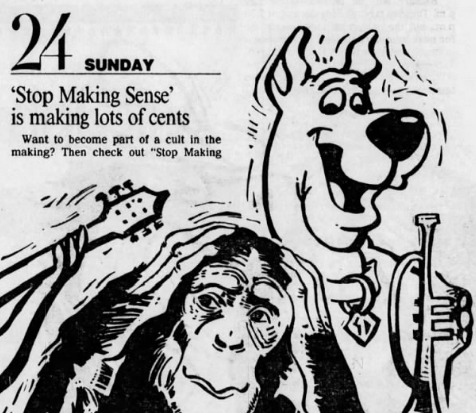
In a mid-sized town like Louisville in the 1980s, I imagine fringe culture tended to consolidate itself into small, overlapping groups. Bookstores, bars, music venues, video stores, coffee shops and art galleries serving the same audiences all overlapped in their programming to some extent.
The Vogue, in addition to showing the movies we’re talking about here, was also an occasional music venue. Its musical programming served a roughly parallel function to its cinematic programming: it was an outlet what used to be called “alternative” culture. A number of Louisville’ earliest punk and new wave shows, in the late 1970s and early ‘80s, happened there.
In fact, on that note, I have an eBay alert set up for “vogue louisville” so I can grab any Vogue-related memorabilia that comes through. Almost nothing does, though recently there’s been someone trying to unload a ticket stub for an Iggy Pop show presented there in partnership with the Kentucky Center for the Arts in 1990. The sort of person who might go see Iggy would also likely be there for the showings that week, which included Pump Up the Volume and Pink Floyd The Wall. Neither of those were exactly countercultural circa 1990, but were certainly adjacent. (Incidentally, I’m a little tempted to buy that Iggy ticket, but it doesn’t even have the name of the Vogue printed on it, so it doesn’t seem like it’s really worth it for my purposes. Still, there it is below.)
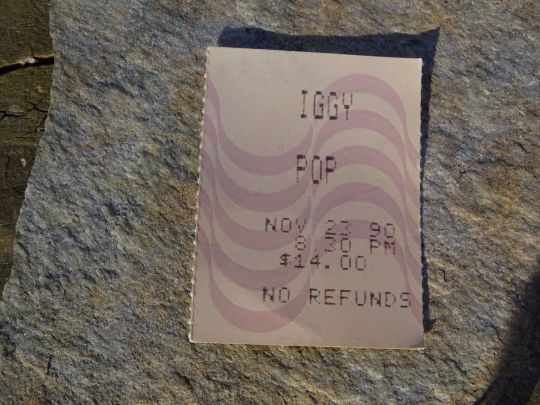
Jonathan Demme’s Stop Making Sense played the Vogue for about two years. Though that was a lot longer than most rock movies, it was far less than, for example, Led Zeppelin’s The Song Remains the Same, which played for ten years, or the aforementioned Pink Floyd The Wall, which showed regularly for almost fifteen, right up until a year before it closed. This tells us that while the Vogue catered regularly to a new wave crowd, their economic bread and butter was either aging boomers or stoned college kids who remained in an oblivious dope haze throughout the events of the 1980s (or possibly both).
But a few times a month for two years indicates there was a healthy interest in Stop Making Sense among a fairly sizable portion of Louisville’s young cultural elite. There were a lot of weirdo bands in Louisville in the mid-1980s, loosely aligned with punk but a little artier, and I wonder how of them were in attendance. Once again, this is one of the big problems with this experiment: watching a lot of these movies on a streaming service on a TV all by myself is so unlike seeing it projected on film in a communal setting with a roomful of people that it barely qualifies as the same experience. It’s like trying to write about having a dinner at the French Laundry by eating a Trader Joe’s frozen quiche lorraine over the sink in your kitchen. Koyaanisqatsi loses a lot in this format, and Stop Making Sense may lose even more.
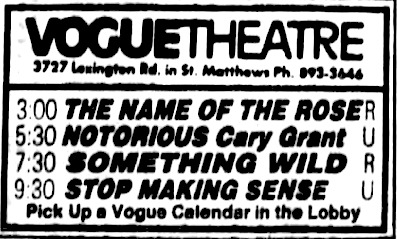
Koyaanisqatsi, which was also on the midnight movie circuit about the same time, is a fully immersive experience, like Stop Making Sense. Demme’s movie, though, goes a step beyond immersion by inviting active participation. It’s shot from the perspective of the audience, with no reaction shots or backstage interviews, and since the audio was recorded digitally, it was crystal-clear, or as crystal-clear as the P.A. allowed at the Vogue. Probably the sound and sights were, in some way, superior to those you might have seen at that Iggy Pop show live in person. Most of the reports from the time -- not in Louisville specifically, but in many places -- make note of people dancing in the aisles. I can imagine it must have been a similar scene at the Vogue.
As a director, I didn’t give any thought Jonathan Demme up until a few years ago. I’d seen Silence of the Lambs, and liked it OK, and although I adored Swimming to Cambodia, I thought that had more to do with Spalding Gray than Jonathan Demme. In a stirring reminder, though, that the internet can still cough up truly remarkable documents that change the way you see the world, I stumbled across this Jacob T. Swinney supercut from 2015. I remember opening it, and scoffing to myself, “oh, so Jonathan Demme is like an auteur now?”
Obviously I was way, way off-base. Three-and-a-half minutes later, the video had made a total convert of me. The way those faces looked at you -- clearly there was something here. I rented all of them over the course of a few weeks, through his early and middle period, from Melvin and Howard through Married to the Mob. I came away with the sensation of falling in love, partially with way of making movies but also with a whole worldview. Demme’s movies find a way to be incredible stylish assemblages of the best parts of North American culture (all accompanied by incredible soundtracks), and also turns its attention to oddballs, misfits and outcasts with a loving gaze that manages to be both amused and compassionate.
Stop Making Sense does all of these things. David Byrne is not warm, exactly, but his arch sense of humor is endearing, and of course he’s one of the great eccentrics of late 20th century American culture. And he’s surrounded by a gang of musicians that seem like they’re right of out of a Demme movie, like the house party at the end of Swing Shift or the Miami hotel pool in Married to the Mob: Chris Frantz in funny-dad mode with a very un-rock-star polo shirt, Bernie Worrell mugging at the camera, Tina Weymouth looking cool in a succession of power suits, Lynn Mabry and Ednah Holt providing synchronized commentary throughout.
It’s only at the end that Demme, as if he’s been teasing you by withholding them, allows some audience shots to sneak in. They look like the sorts of sweet, goony people you’d hope to meet at a Talking Heads show. After every Demme movie, there’s a sense that you, too, could be part of a global community of weirdos who take care of one another.
I can tell you from experience that being weird in a place like Louisville, a town that can be both rigidly conservative and indulgent of eccentricity, could be sort of a lonely experience. It was also the sort of place where there were enough of you out there that you usually found each other somehow. I hope a few of the members of that Demmian-Byrnian community, all out at the Vogue on a Saturday night dancing in the aisles, caught a glimpse of one another when the lights came on.
1 note
·
View note
Photo










1980s Project: 1982 (1 of 3)
48hrs
2020: Texas Gladiators
Android
Battletruck (aka Warlords of the Twenty-First Century)
Blade Runner
Britannia Hospital
Burst City
Class of 1984
Conan the Barbarian
Poltergeist
11 notes
·
View notes
Text
Women’s Bodies & Space to Live
1. Brittany Spears and America's Need to Demonize & Fetishize Women. I lived through Cher, Madonna, disco and the explosion of pornography (Playboy magazine was an acceptable Christmas gift during my childhood). The biggest porn star of my teens was named for character played by Katherine Hepburn and Grace Kelly (The Philadelphia Story and High Society). Anyway, Brittany had some great tracks and her whole marketing scheme (not necessarily thought up by her, remember record label exec, stylists, etc.) was almost-legal sexy kitten. And the music and videos were fun. But because we are uncomfortable w/ young women's sexuality (say ages 13 - 30), Brittany became a lightening rod in the Culture Wars (I'm rolling my eyes at Tipper Gore et al who resurrected parental outrage towards music in the 1980s). On The Media did a nice roundup re: Brittany and Monica and all the other white women who were vilified during the 1990s during the height of the backlash against Second-Wave Feminism. The currently circulating clip of Letterman and Lindsay Lohan illustrate a similar point. Our culture still has a lot of retrograde energy towards young women and their sexuality/freedom. 2. The fetishization of women of color. Someone photoshopped a Superman "S" onto Stacey Plaskett and her blue dress. The rhetoric around Stacey Abrams. Our cultural constructions of Asian women and Southeast Asian women. Latinas. Native American women continue to harmed by the stereotypes that originated w/ the colonizers. Fetishization is dehumanizing and renders these bodies up to the service of the privileged and the powerful to further their needs, wants, and desires. I started listening to The Reckoning yesterday. I also started reading Dress Codes. Black women’s bodies have been contested sites in this country since 1619. It’s Black History Month, so old-heads will show you photos of Black women dressed in respectable ways if as if to say that it’s the lack of girdles, knee-length dresses, hats and gloves that keep racism in place. We’ve internalized the Panopticon. 3. Real Estate. It's a seller's market. Meaning that buyers are going to pay more for housing than usual. Meaning that an increasingly more diverse set of buyers will pay more for housing than the not-so-diverse people who are selling. Meaning that some people who have struggled to gain a foot in the middle-class for generations will be priced out of the market, or be put further into debt to secure the American Dream. A drive around Cleveland reveals sometime dystopian-like stretches of real estate periodically interrupted by revitalized housing for the lucky few. A large public housing development is being demolished to "give the community a better sense of the potential this space (along the Lake Erie at W.25th Street) offers." I cannot find any information on where the inhabitants of the "Big 8" were scattered to. A lakefront Metropark sounds lovely. I find it interesting that in some cities (NYC and Cleveland) public housing was put near waterfront property. I’m assuming those spaces, the water, used to be much more closely tied to industrial usages as opposed to leisure. Waterfront and lake living are huge now. So all those public housing projects, lower SES neighborhoods and their inhabitants must go. The corners of Kinsman, Woodland and East 55th Street offers some of the bleakest views. I'm amazed at how little the landscape at that corner has changed in 24 years. Meanwhile, a block or two away, the Opportunity Corridor project marches forward. The irony of the Juvenile Justice Center being located along the Opportunity Corridor is spectacular. Contrast the rehabbed buildings along Detroit Avenue w/ sparkling gyms in the old-storefront spaces w/ the Woodhill Homes that are in desperate need of rehab and revitalization but have been passed over in two rounds of HUD money. The Opportunity Corridor takes you almost to Woodhill Homes. We ration out Opportunity in this society. Freeing Brittany: <iframe frameborder="0" scrolling="no" height="130" width="100%" src="https://www.wnyc.org/widgets/ondemand_player/wnycstudios/#file=/audio/json/1088476/&share=1"></iframe>
https://www.clevescene.com/scene-and-heard/archives/2020/07/16/metroparks-to-demolish-two-buildings-on-w-25th-street-for-irishtown-bend-project https://www.ideastream.org/tags/woodhill-homes-cleveland-public-housing
https://www.ideastream.org/news/mixed-feelings-as-opportunity-corridor-nears-completion https://dsl.richmond.edu/panorama/renewal/#view=0/0/1&viz=cartogram
0 notes
Text
Exciting New Tools for Designers, September 2020

It’s fun to see new website design tools that reflect current times and the state of the world. That’s very true this month with new databases devoted to diversity and women in technology, as well and resources to make your design life easier.
Here’s what’s new for designers and developers this month:
Ztext.js
Ztext.js is an easy to implement, three-dimensional typography tool for the web that works with any font you want to use. With the popularity of 3D effects and animation, this tool has a lot of practical applications. Everything you need, including documentation, is available from developer Bennett Feely on his website and GitHub. (It’s free but you can show appreciation with a donation if you like it.)

Gradient Magic
Gradient Magic is a free gallery of fun and interesting CSS gradients. You can sort through a random selection or by category of color to find just the right gradient for your project. Some of them would make really neat backgrounds or image overlays.

Impossible Checkbox
Impossible Checkbox is a fun little divot that you’ll want to play with and emulate. Click or tap the slider to activate and a nifty little friend pops up. Now here’s the fun part: You can’t leave it checked, and take note of the changing expression of the checkbox character.

Diversify Tech
Diversify Tech isn’t your average job board; it is a collection of resources – and opportunities – for underrepresented people in technology. It includes a weekly roundup and everything from scholarships, to events, to jobs, to speaking opportunities.

Women in Tech
Women in Tech is a list of apps made by women. The apps are ranked and chosen based on upvotes and is a good resource if you want to help support women-owned projects. Search or submit an app for inclusion.

Devello Studio
Devello Studio is a tool that allows you to write code in the cloud. You don’t have to install anything and no matter where you are, just can open a project in-browser, and continue development where you had left off last time. Plus, it works with GitHub support built right in.

Hustl
Hustl is a premium Mac app that allows you to create time-lapse videos of your screen. Use it to show off work or projects or create a cool video for your portfolio. Plus you can use it to capture just one active app so you don’t have to do a lot of editing later.

FeedBaxley
FeedBaxley is a user feedback tool that helps you (and users) figure out what’s frustrating before it becomes a real issue. You can customize everything to match your brand and set it up with copy and paste tools. Feedback integrates with Slack, making it easy for you to analyze information with a team.

BestTime
BestTime launched a major update with a new tool that makes it possible to analyze visitor peaks of public business (cafe, gym, etc) for whole areas. Using the heatmap API you can find businesses at popular times, locations, or by business type.

Pixeltrue
Pixeltrue is a new collection of free SVG illustrations and Lottie animations in a trendy style. They are available for commercial and personal use and add a bit of whimsical delight to website projects. (The error illustrations are particularly fun.)

Previewed
Previewed has tons of cool and realistic mockups that you can use to create the perfect setting for digital projects. You can find mockups for a variety of devices and cool panoramas that work perfectly for elements such as app store previews.

Alt Text Overlay Bookmarklet
The Alt Text Overlay Bookmarklet solves a common problem: It shows what images use alt text and what that text is. The tool was created by Christian Heilmann and he’s put it on GitHub for you to play with and test.

MergeURL
MergeURL allows you to merge and shorten up to five links. Enter the links and mergeurl.com/o/xxxxx, for example, will open all the URLs associated with that link. The tool is free to use and you don’t have to register to use the service.

Infinity Search
Infinity Search is a new search engine that lets you look for things privately and efficiently. Search the web, images, or videos. Here’s a little about how it works: “While we retrieve results from other search engines like Bing and Wikipedia, we also have our own indexes of links that are displayed in our search results. We are actively working on improving these indexes and they will only get better.”

Blade UI Kit
Blade UI Kit is a set of renderless components to use in Laravel Blade Views. It’s built for the tall stack and is completely open source. It includes 26 components and you can contribute as well.

Trusted News
Trusted News is a Google Chrome extension that uses AI to assist in evaluating the quality of the online content. In its first release, it scores the objectivity for a selected article, testing whether it is written from a neutral perspective as opposed to a subjective one.

BaseDash
BaseDash allows you to edit production data without coding. You can make changes to the database with the ease of a spreadsheet. This tool makes it easy to find and edit information in a hurry. It works with all major databases including MySQL, PostgreSQL, Amazon Redshirt, Microsoft SQL Server, and more.

Email2Go
Email2Go is a service that helps you create email templates and test them on dozens of physical devices and applications. It’s free right now while it is in early release.

Iconscout Converter
The Iconscout Converter allows you to convert icons and images from one file format to another for free. Convert SVG, PNG, JPG, and PDF with a single click.

Shape 2
Shape 2 is a massive collection of 5,000+ unique icons and illustrations with a full-blown web editor. Customize colors, stroke width, size and full variations that can export to SVG, PDF, PNG, GIF, and React. This is a premium tool and includes a discounted release price for now.

Aestetico
Aestetico is a beautiful sans serif that includes a massive family with 54 styles. This premium typeface is highly readable and has modern lines and curves that make it a great option for a variety of uses.

Arcades
Arcades is a modern display font with a retro, 1980s-style vibe. It includes regular and italic styles.

Brimington
Brimington is a handwriting style typeface with rough strokes and smooth curves. It includes a set of 227 characters and 219 glyphs in a readable design.

California Signature
California Signature is a typeface duo with a slab serif and handwriting style that are perfectly paired. The thick and thin options provide a yin and yang effect.

Eastblue
Eastblue is a script typeface with long swashes and interesting curves. It includes a solid character set and is free for personal use only.

Source from Webdesigner Depot https://ift.tt/3cfywkO from Blogger https://ift.tt/3chXMqw
0 notes
Text
This is a memorial website for Ed, a timeline of his life, with links and pictures. This is a very incomplete work in progress. Please check back later for more.
1951-04-04 Ed is born in Brooklyn
1970s Ed is a member of Gay Youth & Gay Activists Alliance
1980 Ed helps found PAD/D at El Bohio
1983-05 PAD/D's art show, Not for Sale: A Project Against Gentrification, at El Bohio.
"It included an exhibition of some two hundred art works, a film and video program, guerilla street-stencil brigades, assorted Punk bands and a cabaret series hosted by the Wow Cafe and Limbo Loung" - Greg Sholette
1983-06-23 NYT mentions the PAD/D show under a column titled "A GALLERY SCENE THAT PIONEERS IN NEW TERRITORIES" and calls it:
an elaborate socio-political roundup - produced by Political Art Documentation/Distribution - of work by artists protesting neighborhood upgrading that sacrifices low-cost housing and its occupants.
For the event organizers, this article prompted soul-searching and fears of cooptation. Janet Koenig joked they had accidentally created "SoHo’s Off-Off West Broadway"
1984 PAD/D's next show, Art for the Evicted: A Project Against Displacement at the boarded-up corner of A & 10tht
For this show, Ed created a poster called Reaganomic Galleries (upload picture from pdf) which was later the subject of Greg Sholette's paper
Craig Owens critiques the show in his article, The Problem With Puerilism, published in the magazine Art In America. (waiting on a copy)
picture of Ed with committee, need to copy
1987-07-14 Ed helps occupy Stapleton, as part of the Coalition for a Nuclear-Free Harbor
They are all arrested, becoming known as the "Stapleton 38"
1988 Ed and the other protesters are tried and convicted. Howard Zinn testifies at their trial. Shortly after, he gets the idea for Groundwork.
1988-12-01 The first World AIDS Day
1988-12-14 First Groundwork flyer drafted
1989 During the spring & summer, Ed leads a team of artists in spraypainting antinuclear messages as part of Groundwork. They will eventually spray 10,000 stencils in all 5 boroughs
Ed helps found REPOhistory
1989-10-21 The Artists for Nuclear Disarmament hold a show for a Nuclear-Free Harbor. Ed sells art at this show. While planning for this show, Ed meets Tom Klem.
1989-10-27 Groundwork press briefing at the Isaiah Wall
1989-12-01 The first Day Without Art, coinciding with World AIDS Day. The Organization of Independent Artists sends out a card, reading:
A National Day of Mourning in Response to the AIDS Crisis The Organization of Independent Artists mourns the loss of our friends and colleagues throughout the art community. This is an announcement card for shows we will never get the chance to see by those who are now gone but live on in our memory.
1989-12-18 Newsday article mentions Groundwork:
Elsewhere, 28 artists are making a political statement about a nuclear-free city harbor in an exhibition called "Groundwork: The Anti-Nuke-port Stencil Project." Images stenciled on streets throughout the five boroughs express the artists' opposition to the navy base being built on Staten Island, which will serve as home port for the USS Iowa and other ships capable of carrying nuclear weapons. Each stencil indicates the distance to the base site.
Village Voice also had an article, Just Say No, with picture of Ed spraypainting a sidewalk. Need to find a copy.
1992-06-23 REPOhistory's Lower Manhattan Sign Project. Ed makes a sign about NYC's underrepresentation in the US Senate, and hangs it on Wall St with Tom Klem

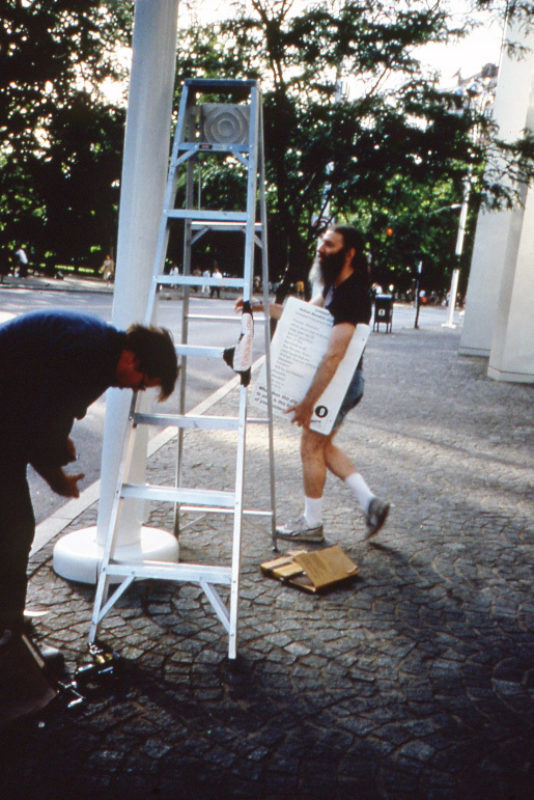
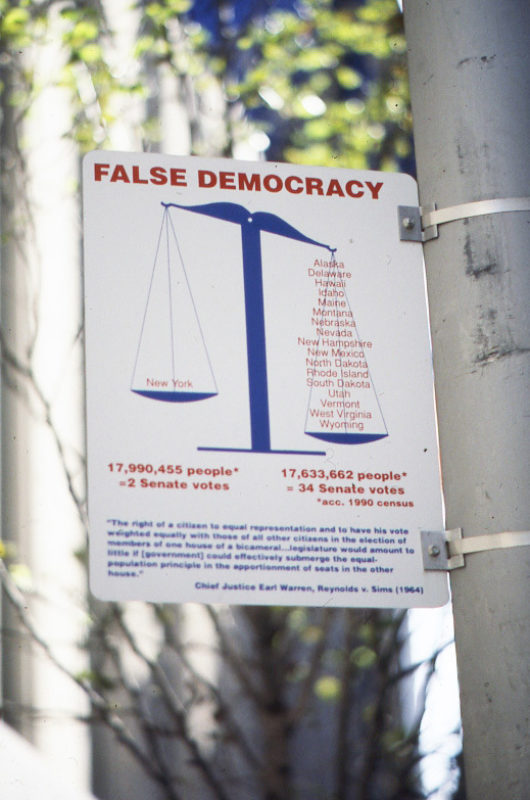
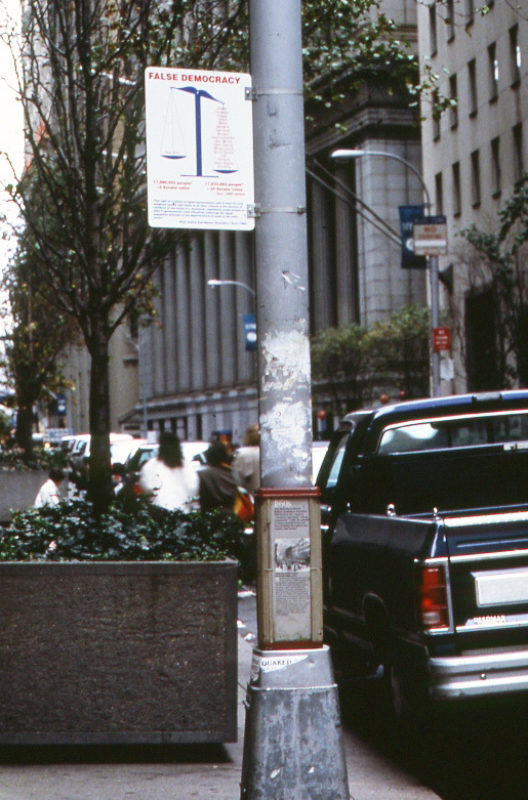
another picture on page 211 (copy from pdf)
1994-05 REPOhistory get permission from NYCDOT to hang temporary signs on streetlamps from June 18 to August 31. The project is called Queer Spaces: Places of Struggle, Places of Strength. Ed helps pressure DOT by threatening a rogue press conference. The signs commemorate queer history landmarks.
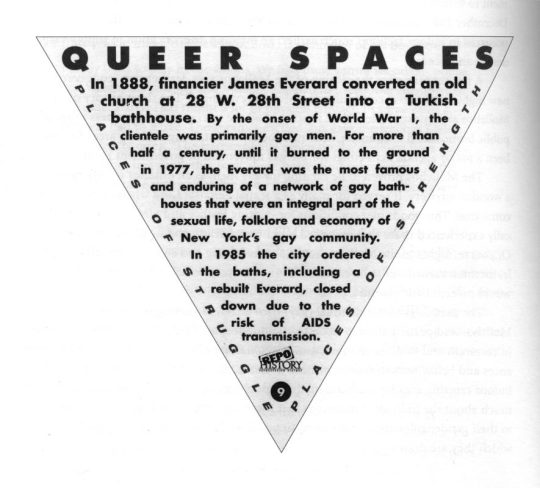
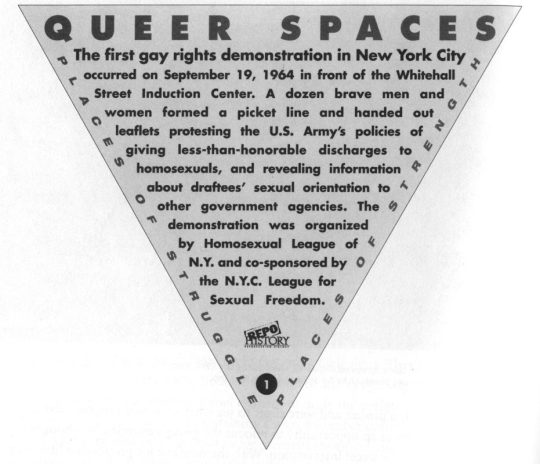
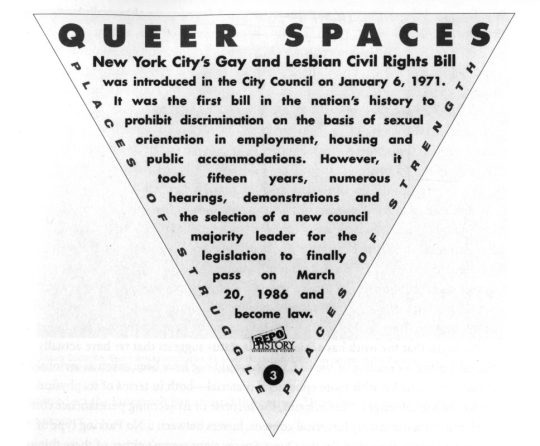
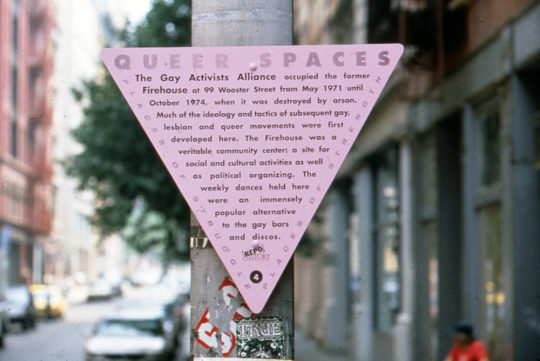
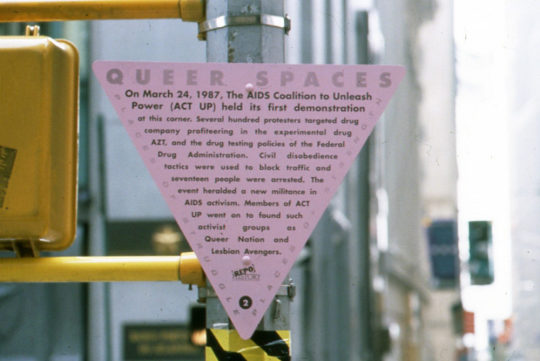
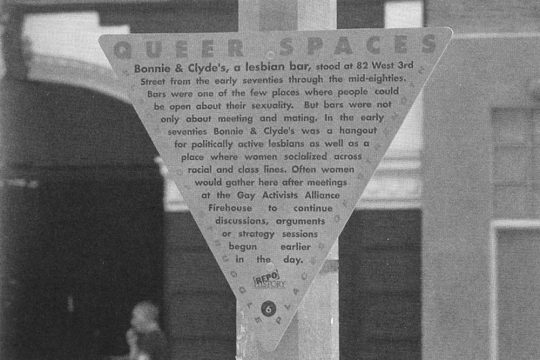
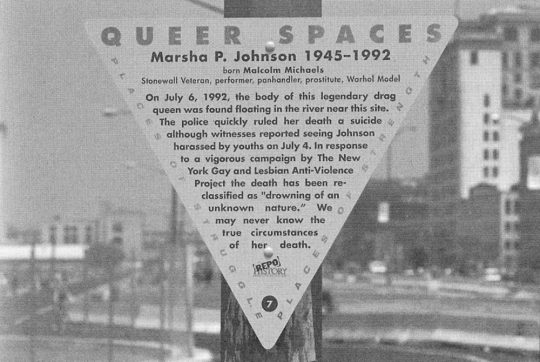
1997 Queers in Space published. Ed co-wrote the chapter called Queer Spaces in New York City, along with Betti-Sue Hertz and Lisa Maya Knauer
1997-09-01 Ed dies of complications from AIDS
1997-12-01 REPOhistory members spraypaint ED in red letters on NYC sidewalks, at least 60 times
2005-03-18 Gregory Sholette writes the paper: Trickle Down Bohemia and the Anti-Capitalist Art of Ed Eisenberg
2007-02-20 Collectivism After Modernism published. Chapter 7, "Artists' Collectives", mentions PAD/D and Ed. (pdf)
2013-11-05 A People's Art History of the United States published. Chapter 25, "Antinuclear Street Art", tells the story of Groundwork. Nicolas Lampert describes Ed as:
a radical Marxist, a gay activist, an artist, and a musician, the type of person whose practice and activism could not be easily categorized
2016-06-22 Surviving REPOhistory members give a panel discussion, Marking LGBT History in the Village and Beyond: A Panel Discussion with REPOhistory Tom Klem's talk begins at 48:55, mentioning Ed several times.
archival sources to research post-plague:
NYU
MOMA
0 notes
Text
68 Cultural, Historical and Scientific Collections You Can Explore Online
https://sciencespies.com/news/68-cultural-historical-and-scientific-collections-you-can-explore-online/
68 Cultural, Historical and Scientific Collections You Can Explore Online
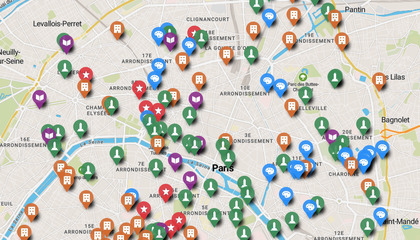
SMITHSONIANMAG.COM | March 23, 2020, 8 a.m.
As efforts to contain the effects of the COVID-19 crisis ramp up, millions of people around the globe are social distancing and self-quarantining themselves in their own homes. To support those in search of diversion from the relentless news cycle, Smithsonian magazine has compiled a collection of 68 online culture, history and science collections you can browse from the comfort of your living room. Whether you’re in the mood to virtually explore ancient Rome, read past presidents’ personal papers or download coloring pages from dozens of international cultural institutions, this roundup has you covered. Listings are bolded and organized by field. (See Smithsonian’s lists of museums you can virtually visit, ways to virtually experience the Smithsonian Institution and Smithsonian educational resources for additional inspiration.)
History

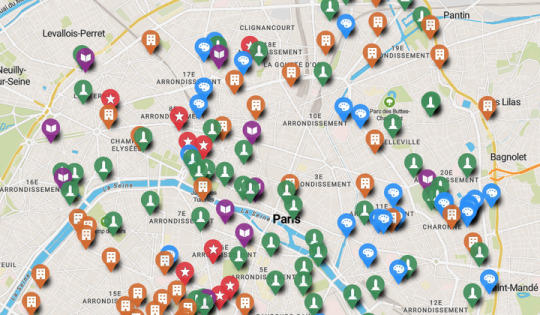
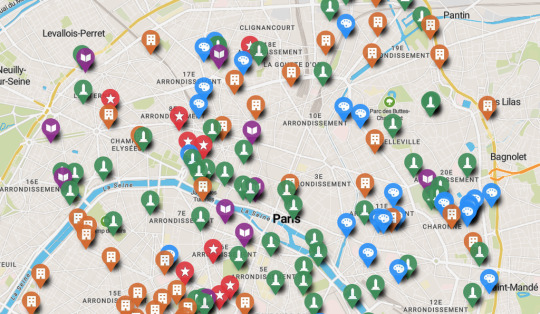

This map of Paris highlights women’s cultural contributions to the French capital.
(Screenshot via Parisian Matrimony)
History lovers may not be able to tour the Smithsonian’s National Museum of American History, the British Museum or the Hermitage in person, but digital history resources spanning time periods, continents and countless topics can provide some respite from these travel woes.
Step back in time via Ancient Athens 3-D or Rome Reborn, then cross the Mediterranean into Egypt for an in-depth look at the famed Nefertiti bust. Other immersive historical offerings include a virtual reality museum featuring five shipwrecked vessels; the Heritage on Edge portal, which tracks climate change’s impact on five Unesco World Heritage Sites; a 3-D digital rendering of Japan’s Shuri Castle, which was ravaged by fire in October 2019; a 3-D scan of the bullets that killed President John F. Kennedy; Below the Surface, a multimedia project that traces Amsterdam’s history through excavated artifacts; and a Sketchfab collection of around 1,700 open-access cultural heritage models, from the Abraham Lincoln Mills life mask to the entrance gates of Ireland’s Menlo Castle and a Scottish boat-building school.
Interactive maps are another option for individuals seeking higher-tech experiences. Google Earth’s Celebrating Indigenous Languages platform spotlights dialects at risk of disappearing, while Parisian Matrimony tracks women’s cultural contributions to the French capital. Mapping the Gay Guides, a newly launched public history initiative, draws on more than 30,000 listings compiled between 1965 and 1980 to visualize American queer spaces’ evolution over time.
Those with more macabre tastes may want to peruse the Survey of Scottish Witchcraft, a tool that visualizes thousands of sites linked with Scotland’s 16th- and 17th-century witch hunts, or the London Medieval Murder Map, which catalogs 142 brutal 14th-century homicides. (In one particularly colorful incident, a man named John de Eddeworth avenged his murdered brother by stabbing the killer “five times with his sword, three times on the back of his head, once on the left side, and once under his left ear.”) Lower-tech maps, including the Library of Congress’ collection of 38,234 digitized travelogues and English king George III’s recently digitized private library of more than 55,000 maps, charts, prints and manuals, are also available.
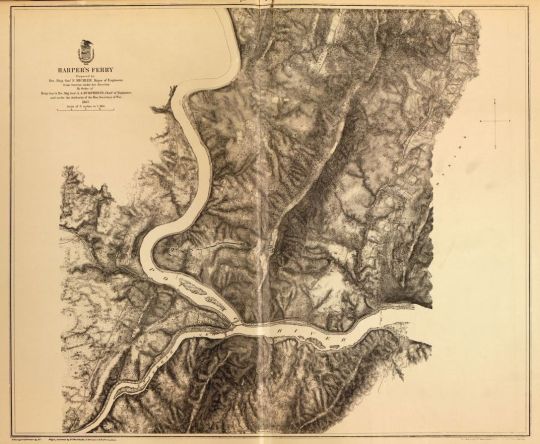
Civil War map of Harper’s Ferry, West Virginia
(Library of Congress)
In the realm of information-heavy databases, highlights range from an index of searchable records that sheds light on New York’s ties to slavery to the Digital Panopticon’s descriptions of 75,688 Victorian-era convicts’ tattoos and the Getty’s archive of 6,000 photos from the waning days of the Ottoman Empire. Troves of digitized documents, meanwhile, run the gamut from historic Mexican cookbooks to a 15th-century British manners book that warns children against picking “thyne errys” and “thy nostrellys,” 155 Persian language texts spanning nearly 1,000 years, one million pages of 16th- through 20th-century content formerly deemed obscene, and the famed Dead Sea Scrolls.
Those hoping to read more personal narratives can check out photographs, prints and papers related to Queen Victoria’s husband, Prince Albert; the only surviving Arabic slave narrative written in the U.S.; and papers penned by such prominent politicians as Theodore Roosevelt, Woodrow Wilson, Warren G. Harding, Benjamin Franklin and Alexander Hamilton. Other public figures whose private lives endure in the digital sphere include civil rights activist Rosa Parks, baseball star Babe Ruth, landscape architect Frederick Law Olmsted, and explorer David Livingstone (as recorded in the diary of his chief attendant, Jacob Wainwright).
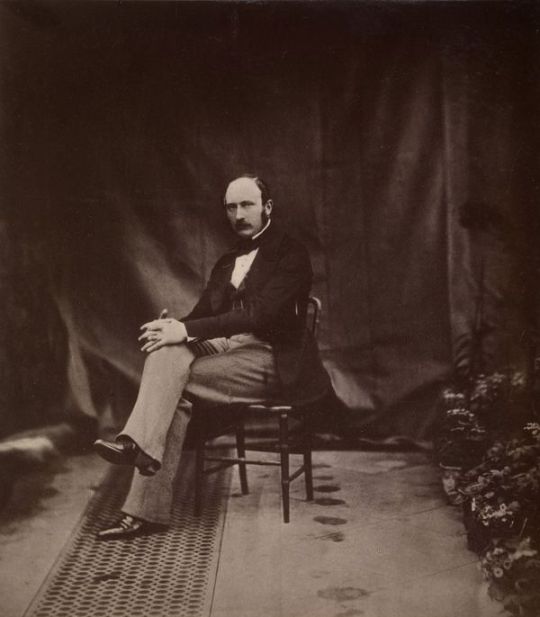
After Roger Fenton, Prince Albert, May 1854, 1889 copy of the original
(Royal Collection Trust / © Her Majesty Queen Elizabeth II 2019)

John Singer Sargent, Frederick Law Olmsted, 1895
(Public domain via Wikimedia Commons)
Arts and Culture
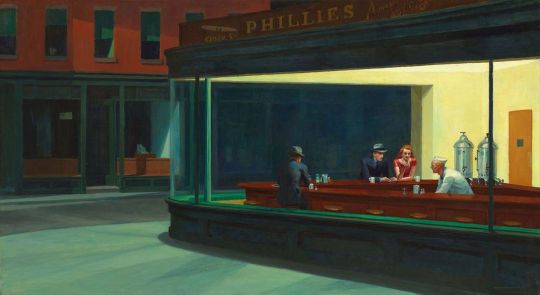
Edward Hopper, Nighthawks, 1942
(Courtesy of the Art Institute of Chicago)
In recent years, museums have increasingly turned to digitization as a tool for widening access to their collections. Among the major cultural institutions with digitized—and often open access—offerings are the Smithsonian, which released 2.8 million images into the public domain earlier this year; Paris Musées, which oversees 14 major museums in France’s capital; nonprofit organization Art U.K.; the Art Institute of Chicago; Taiwan’s National Palace Museum; the Metropolitan Museum of the Art; the National Gallery of Art in Washington, D.C.; the Getty; the Wellcome Library; the Museum of New Zealand; and the Uffizi Galleries. Examples of artworks, artifacts and texts available for download include British psychiatric institutions’ 18th- through 20th-century records, Vincent van Gogh’s The Bedroom and Han dynasty jades.
In addition to digitizing broader collections, many museums have curated archives dedicated to specific topics: The Kunsthaus Zürich has an extensive trove of Dada documents that defy the movement’s long-held association with ephemerality, while the Delaware Art Museum has a portal of papers associated with the Pre-Raphaelite Brotherhood. Illinois State University’s Milner Library offers a digital collection dedicated to the history of circus. The San Francisco-based Letterform Archive has a digital archive of typographical artifacts. And Chicago’s Newberry Library provides online access to more than 200,000 images documenting the history of early America and westward expansion, including watercolors and colored pencil drawings by 19th- and 20th-century Lakota children.
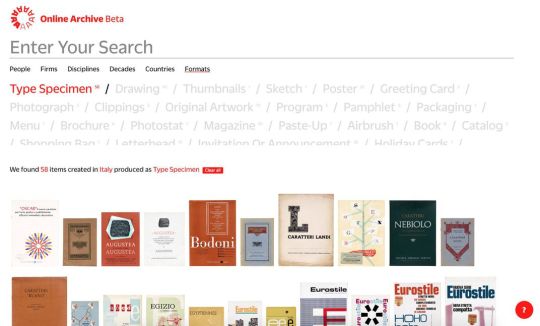
The portal allows users to narrow down search results by “design-specific” terms, as well as geographic, chronological parameters.
(Courtesy of Letterform Archive)
Two giants of the digital cultural sphere—Google Arts & Culture and the Library of Congress—are each home to a dizzying number of virtual resources. The former offers experiences covering 3,000 years of fashion, Pieter Bruegel the Elder’s unseen masterpieces, Latino culture in the U.S., Banksy’s most famous murals, Vermeer’s surviving paintings, armor through the ages, Easter Island and many more topics. The latter has, among others, collections of rare children’s books, Taiwanese watercolors and Chinese texts, braille sheet music, travel posters, presidential portraits, baseball cards, and images of cats and dogs. See the library’s database of digital collections for a more exhaustive overview.
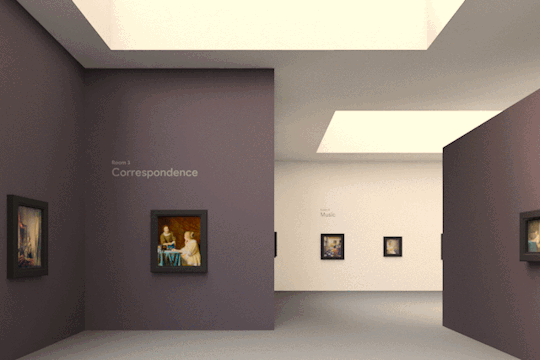
The virtual museum features seven rooms focused on themes such as correspondence, music and flirtation.
(Pocket Gallery / Google Arts & Culture)
Other out-of-the-box ideas include using an app that guides readers through Chaucer’s Canterbury Tales; downloading free coloring pages compiled during the annual #ColorOurCollections campaign—offerings range from a zany 1920s advertisement for butter to medical drawings, book illustrations and a wartime nurse recruitment poster; or reading the New York Public Library’s interactive Insta Novel versions of Alice’s Adventures in Wonderland, Charlotte Perkins Gilman’s “The Yellow Wallpaper” and Kafka’s The Metamorphosis.

Aubrey Beardsley’s illustration for Salome by Oscar Wilde
(Courtesy of the British Library)
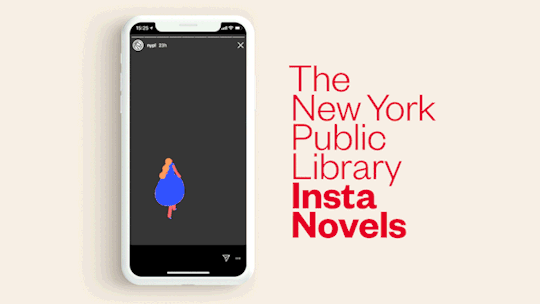
The NYPL’s Insta Novels are available via Instagram.
(Courtesy of the New York Public Library)
Another option for individuals with ample time on their hands is transcribing historical documents and data. The Smithsonian Transcription Center is always looking for volunteers to log field notes, diaries, ledgers, manuscripts and biodiversity specimen labels. Other offerings include the Library of Congress’ By the People project, which asks users to transcribe collections related to women’s suffrage, Rosa Parks, Abraham Lincoln and Spanish law; the Newberry Library’s Transcribing Faith portal, which seeks volunteers eager to analyze early modern manuscripts; and the Citizen Archivist, which asks participants to tag, transcribe and add comments to the National Archives’ records.
Science

The blue-throated barbet, illustrated here in 1871, is native to southern Asia.
(Courtesy of the Biodiversity Heritage Library)
Flowers, fungi and fauna abound in digitized renderings of the natural world. The open-access Biodiversity Heritage Library, for instance, highlights more than 150,000 illustrations ranging from animal sketches to historical diagrams and botanical studies; the Watercolor World, a portal created to serve as a “visual record of a pre-photography planet,” showcases more than 80,000 paintings of landscapes, seascapes, buildings, animals, plants, ordinary people and historical events.

Maria Sibylla Merian, Untitled (Toucan), 1701–1705
(© Trustees of the British Museum)
Other digital science resources include an interactive map that lets users plug in their address to see how it’s changed over the past 750 million years, a collection of unsettling sounds from outer space, Cambridge University’s Isaac Newton papers, Charles Darwin’s manuscripts, hundreds of case files written by a pair of 17th-century astrologers and physicians, a map that visualizes all 21 successful moon landings, and a medical pop-up book dating to the 17th century.
#News
1 note
·
View note